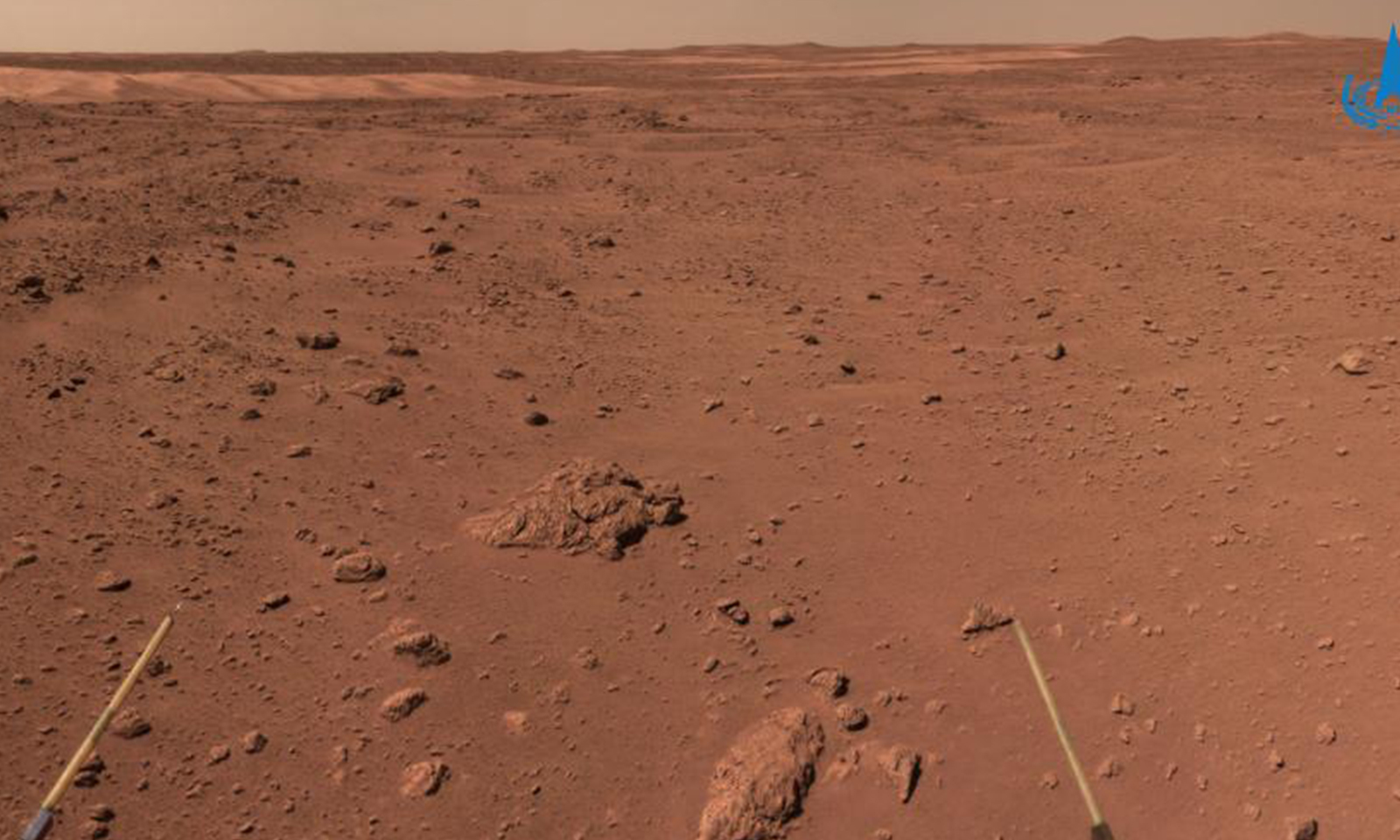Science & Technology
တရုတ်နိုင်ငံ၏ အင်္ဂါဂြိုဟ်ပေါ်သွားယာဉ်က သတ်မှတ်ထားသော စူးစမ်းရှာဖွေရေးလုပ်ငန်းများ ပြီးမြောက်လျက်ရှိ

ပေကျင်း၊ ဩဂုတ် ၁၈ ရက် (ဆင်ဟွာ)
တရုတ်နိုင်ငံ၏ အင်္ဂါဂြိုဟ်ပေါ်သွားယာဉ် ကျူးလုံ (Zhurong) သည် သတ်မှတ်ထားသည့်အတိုင်း ၎င်း၏ စူးစမ်းလေ့လာရေးနှင့် ရှာဖွေတွေ့ရှိရေး လုပ်ငန်းများ ပြီးမြောက်လျက်ရှိကြောင်း တရုတ်နိုင်ငံ အမျိုးသား အာကာသစီမံခန့်ခွဲမှုဦးစီးဌာန (CNSA) က ဩဂုတ် ၁၇ ရက်၌ ပြောကြားခဲ့သည်။၂၀၂၁ ခုနှစ် ဩဂုတ် ၁၅ ရက်အထိ ကျူးလုံယာဉ်သည် ရှာဖွေရေးလုပ်ငန်းများ ဆောင်ရွက်ရန် သိပ္ပံပညာရပ်ဆိုင်ရာ ပစ္စည်းကိရိယာများအားလုံး စတင်လုပ်ဆောင်ခြင်းနှင့်အတူ အင်္ဂါဂြိုဟ်မျက်နှာပြင်တွင် အင်္ဂါဂြိုဟ်သက် ရက်ပေါင်း ၉၀ သို့မဟုတ် ကမ္ဘာဂြိုဟ်ပေါ်ရှိ ရက်ပေါင်း ၉၂ ရက်ခန့်ကြာ လုပ်ဆောင်ခဲ့ပြီးဖြစ်ကြောင်း အဆိုပါ ဦးစီးဌာနက ပြောခဲ့သည်။
အဆိုပါ ယာဉ်သည် ဩဂုတ် ၁၅ ရက်အထိ ၈၈၉ မီတာ ခရီးနှင်ခဲ့ပြီးဖြစ်ကြောင်းနှင့် သိပ္ပံပညာရပ်ဆိုင်ရာ ပစ္စည်းကိရိယာများကလည်း အချက်အလက်ကုန်ကြမ်း 10 Gb ခန့် စုဆောင်းထားပြီးဖြစ်ကြောင်း၊ ယခုအခါ ၎င်းယာဉ်သည် တည်ငြိမ်စွာ မောင်းနှင်နေပြီး လုံလောက်သောစွမ်းအင်၊ ကောင်းမွန်သော အခြေအနေဖြင့် လည်ပတ်နေကြောင်း သိရသည်။
ကျူးလုံယာဉ်သည် Utopia Planitia တောင်ဘက်ပိုင်းရှိ ရှေးဟောင်းပင်လယ်နှင့် ရှေးဟောင်းကုန်းမြေကြား နယ်စပ်ဇုန်အထိ ဆက်လက်ရွေ့လျားသွားမည်ဖြစ်ပြီး ထပ်တိုးလုပ်ငန်းများ ဆက်လက်လုပ်ဆောင်သွားမည်ဖြစ်ကြောင်း CNSA က ဖြည့်စွက်ပြောကြားခဲ့သည်။
ကျူးလုံသည် စူးစမ်းလေ့လာရေးနှင့် ရှာဖွေရေးလုပ်ဆောင်စဉ်အတွင်း ၇ ရက်ပတ်လုံး လည်ပတ်ခဲ့ကြောင်း၊ ၎င်း၏ တည်နေရာပြမြေပြင်ကင်မရာက ယာဉ်၏လမ်းကြောင်း အစီအစဉ်နှင့် ရည်မှန်းထားသော ရှာဖွေရေးနေရာရွေးချယ်မှုအား ပံ့ပိုးရန် လမ်းကြောင်းတစ်လျှောက် topographic အချက်အလက်ကို ရရှိထားခဲ့ကြောင်း ဦးစီးဌာန၏ ပြောကြားချက်အရ သိရသည်။
ကျူးလုံ၏ မျက်နှာပြင်ခွဲ ရှာဖွေရေးရေဒါက အင်္ဂါဂြိုဟ်မျက်နှာပြင်အောက်ရှိ အလွှာတည်ဆောက်ပုံ အချက်အလက်မျက်နှာပြင် သံလိုက်စက်ကွင်းရှာဖွေရေးကလည်း နယ်ခံသံလိုက်စက်ကွင်း အချက်အလက်များ ရရှိထားကြောင်းနှင့် အင်္ဂါဂြိုဟ်၏ သံလိုက်စက်ကွင်း ဆင့်ကဲပြောင်းလဲမှုဖြစ်စဉ်ကို စူးစမ်းလေ့လာရန် ဂြိုဟ်ပတ်လမ်းကြောင်းရှိ သံလိုက်သုံးလျှပ်စစ်ဂျင်နရေတာမီတာနှင့် ပူးပေါင်းလုပ်ဆောင်ခဲ့ကြောင်း သိရသည်။
ယာဉ်ပေါ်ရှိ သိပ္ပံပညာရပ်ဆိုင်ရာပစ္စည်းကိရိယာ ၇ မျိုးမှ စုဆောင်ထားသော အချက်အလက်များအား အစီအစဉ်တကျဆောင်ရွက်ခြင်းနှင့် စိစစ်ခြင်းများ လုပ်ဆောင်လျက်ရှိသည်။ တရုတ်သုတေသနအဖွဲ့များအနေဖြင့် CNSA ၏ လမျက်နှာပြင် စူးစမ်းလေ့လာရေးနှင့် အာကာသ အစီအစဉ်စင်တာမှ လည်ပတ်သော အဖွဲ့အစည်းတစ်ခုဖြစ်သည့် တရုတ်နိုင်ငံ၏ လမျက်နှာပြင်နှင့် နက်ရှိုင်းသောအာကာသ စူးစမ်းလေ့လာရေးထံ လျှောက်ထားနိုင်ကြောင်း CNSA က ပြောခဲ့သည်။
အချက်အလက်များအား လစဉ် ထုတ်ပြန်သွားမည်ဖြစ်ကြောင်း CNSA က ဖြည့်စွက်ဖော်ပြထားသည်။
တရုတ်နိုင်ငံက ဂြိုဟ်ပတ်လမ်းကြောင်းသွားယာဉ်၊ ဂြိုဟ်ပေါ်ဆင်းသက်ယာဉ်နှင့် ဂြိုဟ်ပေါ်သွားယာဉ်တို့ ပါဝင်သော ထျန်းဝန်-၁ မစ်ရှင်အား ၂၀၂၀ ပြည့်နှစ် ဇူလိုင် ၂၃ ရက်၌ လွှတ်တင်ခဲ့သည်။
အနည်းဆုံး အင်္ဂါဂြိုဟ်သက် ရက်ပေါင်း ၉၀ သို့မဟုတ် ကမ္ဘာဂြိုဟ်ပေါ်တွင် သုံးလခန့် သက်တမ်းရှိနိုင်မည်ဟု ခန့်မှန်းထားသော ဂြိုဟ်ပေါ်သွားယာဉ်အား တင်ဆောင်ထားသည့် ဆင်းသက်ယာဉ်သည် အင်္ဂါဂြိုဟ်၏ မြောက်ဘက် ကျယ်ပြန့်သောကွင်းပြင်ဖြစ်သော Utopia Planitia ၏ တောင်ဘက်ခြမ်း၌ မေ ၁၅ ရက်က ဆင်းသက်ခဲ့သည်။
ကျူးလုံယာဉ်သည် မေ ၂၂ ရက်တွင် ယာဉ်ဆင်းသက်ရာပလက်ဖောင်းမှ အင်္ဂါဂြိုဟ်မျက်နှာပြင်ပေါ်သို့ ဆင်းသက်ကာ ဂြိုဟ်နီကြီး (အင်္ဂါဂြိုဟ်) စူးစမ်းလေ့လာရေးကို စတင်လျက်ရှိသည်။ (Xinhua)
————————————————–
(English Version)
China’s Mars rover accomplishes planned exploration tasks
BEIJING, Aug. 17 (Xinhua) — China’s Mars rover Zhurong has accomplished its exploration and detection tasks as planned, according to the China National Space Administration (CNSA) on Tuesday.
As of Aug. 15, 2021, Zhurong had worked on the surface of Mars for 90 Martian days, or about 92 days on Earth, with all scientific payloads having started to work on detection tasks, said the administration.
The rover has traveled 889 meters as of Aug. 15, and its scientific payloads have collected about 10 Gb of raw data. Now the rover runs stably and operates in good condition with sufficient energy.
The CNSA added that the rover will continue to move to the boundary zone between the ancient sea and the ancient land in the southern part of Utopia Planitia and will carry out additional tasks.
According to the administration, Zhurong operated with a cycle of seven days during its exploration and detection. Its navigation terrain camera obtained topographic data along the way to support the rover’s path planning and detection target selection.
Zhurong’s subsurface detection radar acquired the data of the layered structure below the Martian surface.The surface magnetic field detector obtained local magnetic field data and cooperated with the magnetometer in the orbiter to explore the evolution process of the Mars magnetic field.
The CNSA said the data collected by seven scientific payloads aboard the rover have been processed and verified. Chinese research teams can apply to China’s Lunar and Deep Space Exploration, an organization operated by CNSA’s Lunar Exploration and Space Program Center.The data will be released monthly, the CNSA added.
China’s Tianwen-1 mission, consisting of an orbiter, a lander, and a rover, was launched on July 23, 2020.The lander, carrying the rover with an expected lifespan of at least 90 Martian days or about three months on Earth, touched down in the southern part of Utopia Planitia, a vast plain in the northern hemisphere of Mars, on May 15.
Zhurong drove down from its landing platform to the Martian surface on May 22, starting its exploration of the red planet. Enditem
Photo released by the China National Space Administration (CNSA) shows an image taken by the navigation terrain camera onboard the rover Zhurong. (CNSA/Handout via Xinhua)






